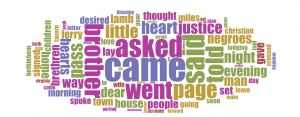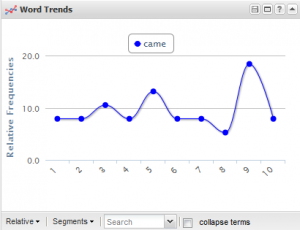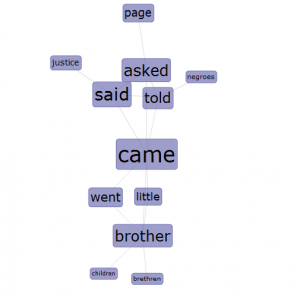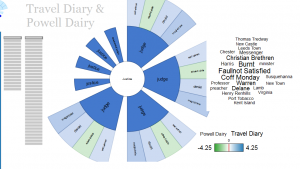During the process of learning about Distant Reading last week, I found it quite interesting to capture the beauty of Distant Reading. Distant Reading, as Whitley mentioned in her writing, is not to take the place of traditional close reading, but to give readers a broader view of the whole documents in a quantitative other than qualitative way.
This is quite apparent when related to personal reading experiences. People intend to pay more attention to the feeling changes of the characters in the whole story since words are qualitative. In this case, you need to sniff what is hidden underneath the word, not just the word itself. However, various digital tools give us a more clear way, through giving numerical data, tree maps and other methods, to view the whole document in distance calmly and dispassionately. We transcribed the travel journal by Jasper Payne in 1747. At first, we read it as usual to get a general view of what they did every day during the journey, how they crossed the river, met the Justice and talked to Negroes. As Payne himself heavily involved in the event, his perspective is quite related to his religion and personal characteristic. In this case, readers will feel themselves also heavily got involved when reading. However, as we put the Travel Diary into Cirrus, one Voyant tool, the screen shows as follow.

When click at a specific word, a axis graph on the top right shows the frequency of this word that appears in the text.

By studying this kind of graphs, we will be confused about what the logical relationship within the text and get a more clear view of what is going on quantitatively.

Link is another representative tool to re-process this travel journal. As it not only display distant reading, but also spatial reading, the key words in the document are showed how they relate to each other. Another very interesting point in Whitley reading is related to the Poetess Archives, a visualization project that relate the flowery poetry in Britain and America between 1750 to 1900. This is quite attractive to me since human eyes are not able to directly gather these two together in a short period of time, but DH can. As what we did during today’s class, we put Travel Diary and Powell Diary, two documents which similar but not not, together in the DocuBurst. The image below is what came out in one second. This is really cool to use digital tools to connect 2 old documents.

Leave a Reply